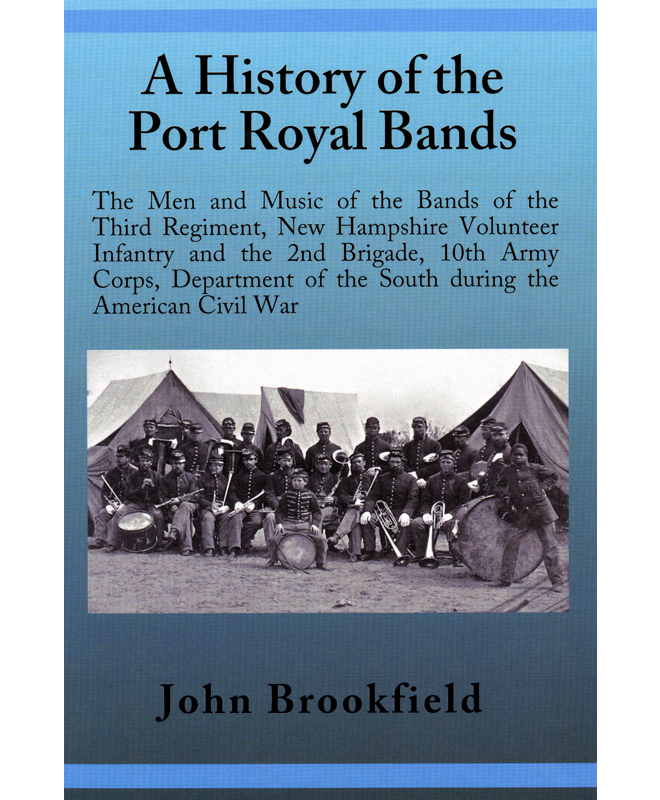 John Brookfield. A History of the Port Royal Bands: The Men and the Music of the Bands of the Third Regiment, New Hampshire Volunteer Infantry and the 2nd Brigade, 10th Army Corps, Department of the South during the American Civil War. South China, ME: Sam Teddy, 2015. Price $37.95; 441pp.
John Brookfield. A History of the Port Royal Bands: The Men and the Music of the Bands of the Third Regiment, New Hampshire Volunteer Infantry and the 2nd Brigade, 10th Army Corps, Department of the South during the American Civil War. South China, ME: Sam Teddy, 2015. Price $37.95; 441pp.
For enthusiasts and scholars of brass-band music of the American Civil War (1861–65), the few surviving sets of band partbooks are treasured as the clearest windows into what was actually played by bands during that war. While recollections by soldiers who name certain tunes are helpful, these non-musicians usually only recognized certain patriotic airs or the occasional popular song.
The partbooks, however, contain a varied repertoire that included transcriptions of opera scenes and piano music, as well social dance music, and arrangements of ethnic tunes (minstrel songs, Irish, Scottish, and German tunes). The painfully few complete, or near complete, sets of band books are thus given extraordinary value, and perhaps a bit too much historical importance. This is certainly the case for the so-called “Port Royal Band” books, named for the South Carolina town near Hilton Head where the 3rd New Hampshire Volunteer Infantry Regiment was stationed. The band, led by Gustavus Ingalls, was attached to the regiment until dissolution of the regimental bands in late 1862. Ingalls returned in early 1863 with a band of new and former members to become the band of the 2nd Brigade of the U.S. 10th Army Corps, serving the Hilton Head fortifications, primarily. The moniker, “Port Royal” was given to the band and books, by Frederick Fennell in the 1960s, and it has served as an accepted shorthand designation ever since.
Naturally, there is interest in the musicians who played the music that we can hold in our hands. John Brookfield’s long-awaited book on the Port Royal band and its music offers a look into the community and the men who served in the two versions of the band. It is published by Sam Teddy, an outfit that has brought to print a good number of Civil War titles recently. Brookfield’s research is impressive. As a resident of Merrimack County, NH, his familiarity with the locations and family names no doubt aided his collection of information on the band members. The membership is the primary focus of the book, which is organized chronologically with the formation of the early Fisherville Band, followed by the Civil War service of its successor, and concluded with postwar activities of the members.
Brookfield’s book is a more documentary than narrative product. Rather than summarize his findings, he lays them out for the reader to inspect, sometimes followed by his commentary. For example, each band member is identified in turn with primary source documents, but no description from the author. It is here that Brookfield’s gained knowledge of the people would be helpful. Most of the narrative text comes in the form of first-person reminiscences of band members. Rather than connect the sources with his own voice, Brookfield lets the band members tell their story through an unusually rich number of these remembrances. Particularly valuable is bandsman Henry Hamilton’s descriptions of the famous photos taken of the camp life of the band in early 1862 at Port Royal. This approach has its merits, but a casual reader would likely appreciate a more narrative approach by the author, with selected quotes from the reminiscences. For example, in the first description of Fisherville (now Penacook, NH), rather than reproduce the rather sterile source he presents, the author might have offered a vivid description of the place as it existed in the mid 19th century, including the natural beauty of the area, the primary occupations of its inhabitants, and the proportion of each religious denomination there. This would have given an important context to the personalities of each band member.
The centrality of the people in Brookfield’s book is evident, but it is disappointing that he devoted only ten pages to the band books, offering little more than bibliographic information on them. What do the contents tell us about their repertoire? Book 3 is one of the rare collections of music that dates exactly to the war years. What does it tell us about what played well at the Hilton Head post? Some of this appears in the individual members’ entries, but one would have to hunt for them.
Overall, John Brookfield’s work is a welcome addition to the knowledge of Civil War bandsmen. While his choice to make the book into a curated collection of documents is at the expense of a vivid narrative, it does offer a great deal of valuable information not only for the researcher, but perhaps more importantly, for the people of Merrimack County, who count these men as ancestors and former community members.
Michael B. O’Connor



